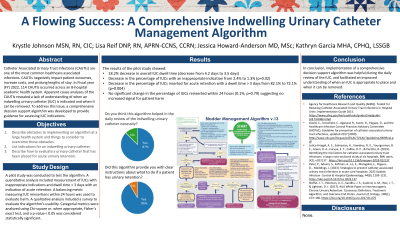Quality Assurance and Performance Improvement
Category: Quality Assurance and Performance Improvement
Poster Theater Session IV
QAPI 114 - A Flowing Success: A Comprehensive Indwelling Urinary Catheter Management Algorithm
Tuesday, June 4, 2024
11:30 AM - 11:35 AM CST
Location: Digital Poster Theater - APIC Central, Hall 1

Has Audio

Krystle Johnson, MSN, RN, CIC (she/her/hers)
Manager, Infection Prevention
Emory Healthcare
Presenter(s)
Disclosure(s):
Krystle Johnson, MSN, RN, CIC: No financial relationships to disclose
Background: Catheter Associated Urinary Tract Infections (CAUTIs) are one of the most common healthcare associated infections. CAUTIs negatively impact patient outcomes, increase costs, and prolong lengths of stay. In Fiscal year 2022, 114 CAUTIs occurred across an 8-hospital academic health system. Apparent cause analyses of the CAUTIs revealed a lack of understanding of when a urinary catheter (UC) is indicated and when it can be removed. To address this issue, a comprehensive decision support algorithm was developed to provide guidance for assessing UC indications.
Methods: A pilot study was conducted to test the algorithm. A quantitative analysis included measurement of UCs with inappropriate indications and dwell time > 3 days with an indication of acute retention. A balancing metric measuring UC reinsertions within 24 hours was used to evaluate harm. A qualitative analysis included a survey to evaluate the algorithm’s usability. Categorial metrics were analyzed using Chi-square or, when appropriate, Fisher’s exact test, and a p-value < 0.05 was considered statistically significant.
Results: The results of the pilot study showed a decrease in the percentage of UCs with inappropriate indications from 2.4% to 1.3% (p=0.02), and a decrease in the percentage of UC inserted for acute retention with a dwell time > 3 days from 82.1% to 72.1% (p=0.004). There was no significant change in the percentage of UCs reinserted within 24 hours (0.1%, p=0.79) suggesting no increased signal for patient harm. The qualitative survey results demonstrated that 86% of staff agreed the algorithm helped in the daily review of UC indications.
Conclusions: In conclusion, implementation of a comprehensive decision support algorithm was helpful during the daily review of the UC, and facilitated an improved understanding of when an indwelling UC can be removed. A multidisciplinary approach to CAUTI prevention was shown to be effective in this healthcare system.
Learning Objectives:
- Describe obstacles to implementing an algorithm at a large health system and things to consider to overcome these obstacles.
- List indications for an indwelling urinary catheter.
- Describe how to evaluate a urinary catheter that has been placed for acute urinary retention.

